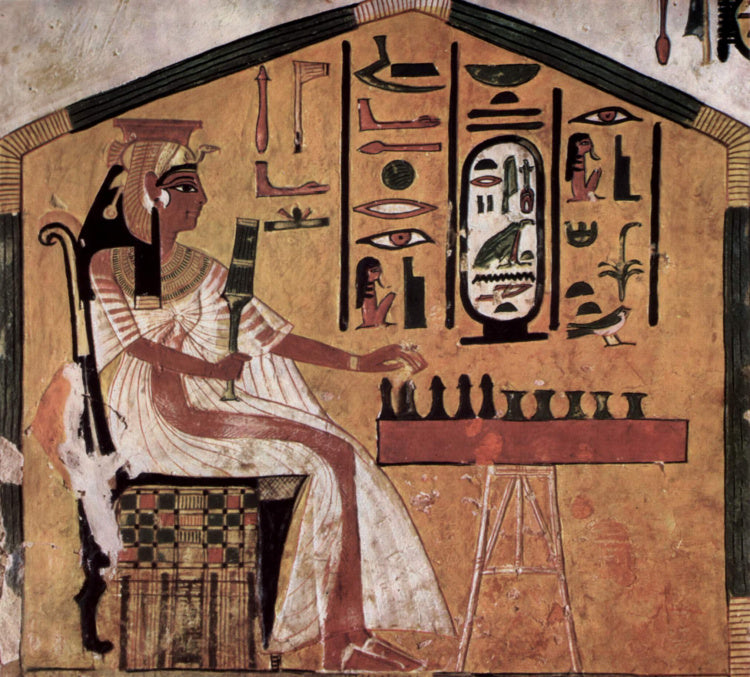
How to Play Senet
Share
Senet is an ancient board game originating in Egypt. Game play is a mix of luck and strategy, relying on throws of "sticks," the ancient equivalent of game dice, to determine how many spaces you can move one of your five pieces. The goal of the game is to be the first to move all five of your pieces off the board. While your stick throws have a great deal of influence on game play, the interactions with your opponent's pieces add an extra level of strategy to each move.
To the Egyptians, this game represented the journey through the realm of the dead to reach the god Osiris, so the game is often found in ancient tombs or depicted in funeral art.

The Board and Pieces:
The Senet board is three rows of ten squares and meant to be traversed in a serpentine path. There are also five special squares on the board to add further complication to the game (we'll get into what those do later). The board squares are numbered left to right for the first row (1 through 10), then right to left for row two (11 through 20), and finally left to right once more for the final row (21 through 30)
Traditional Senet uses sticks instead of dice. Sticks have a dark side and a light side, and the light side is considered the "face." You toss 4 sticks and the number that land face up determines how many spaces you can move your pieces.
The game is simple enough that you could easily craft one yourself as simply as printing out a grid, using different colored marbles for the game pieces, and replacing the sticks with coins (heads or tails replacing "face up" or "face down" sticks) or dice. That said, there are some gorgeous Senet boards available for purchase, so if you enjoy the game, you may want to invest in a centerpiece gameboard that makes you feel like a pharaoh.
Set Up:
To start the game, line up the player pieces, alternating between each color, along the first row of ten. Different boards have different color pieces (and some sets have different shapes instead of different colors), but for this explanation we're going to call the teams "black" and "white."
Game Play:
The first piece to move must be the piece in space "10." The pieces will progress first along the left-ward path, depending on the sticks. The players take turns moving pieces. If you land on top of another piece, you swap places with it, sending it back to the space you came from. This includes your own pieces as well as your opponent's.
You can jump over pieces.
If two pieces of the same color are side by side, you cannot land on their space.
If no space is available for you to move to within the count of your stick throw, you forfeit your turn, and your opponent goes instead.
Stick Throws:
Note: Different sources have different interpretations for stick throws. If you purchase a game board that comes with instructions, they may vary from what is written here.
1 white side up = move 1 square and throw again
2 white sides up = move 2 squares
3 white sides up = move 3 squares
4 white sides up = move 4 squares and throw again
4 black sides up = move 6 squares and throw again
Special Spaces:
Special spaces are marked in some way, usually with a hieroglyph, and have their own distinct rules. There are variations on the game, but the most common special spaces are the following:
- Square 15-Power of Life: This is a "safe" space. Your piece cannot be attacked and sent backwards when it is here.
- Square 26-House of Beauty: Same as square 15, this is also a safe space where your piece cannot be attacked.
- Square 27-House of Water: Landing here sends you backwards to the Power of Life (square 15) spot. If square 15 is occupied by another piece, roll again.
- Square 28-House of Three Spirits: While this is also a safe square, it is a simultaneously a trap. Once you land here, you cannot move that piece unless your sticks roll 3 sides up.
- Square 29-The House of Twos: Similar to square 28, House of Twos is safe but a trap. You need to a throw of 2 to escape.
Winning:
The first person to move all their pieces down the path and off the board is the winner.
While Senet is fairly simple, the elements of chance and strategy combine for endless variations of game play.
Love games? Mythologie Candles is hosting a giveaway and treasure hunt for our Sands of Time release and one of the prizes is a gorgeous Egyptian board game.